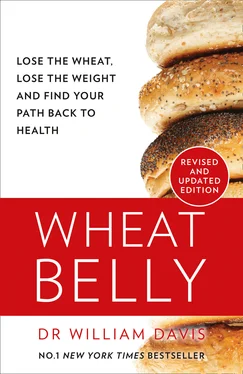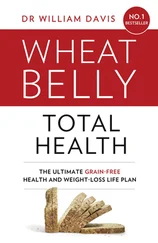Advice to consume more healthy whole grains therefore causes increased consumption of the amylopectin A form of wheat carbohydrate, a form of carbohydrate that, for all practical purposes, is little different, and in some ways worse, than dipping your spoon into the sugar bowl.
GLUTEN: WE HARDLY KNOW YA!
If you were to add water to wheat flour, knead the mixture into dough, then rinse the glob under running water to wash away starches and fiber, you’d be left with a protein mixture called gluten.
Wheat is the principal source of gluten in the diet, both because wheat products have come to dominate and because most Americans do not make a habit of consuming plentiful quantities of barley, rye, bulgur, kamut, spelt, einkorn, emmer, or triticale, the other sources of gluten. For all practical purposes, therefore, when I discuss gluten, I am primarily referring to wheat.
While wheat is, by weight, mostly amylopectin A carbohydrate, gluten protein is what makes wheat “wheat.” Gluten is the unique component of wheat that makes dough “doughy”: stretchable, rollable, spreadable, twistable, baking gymnastics that cannot be achieved with rice flour, corn flour, or any other grain. Gluten allows the pizza maker to roll and toss dough and mold it into the characteristic flattened shape; it allows the dough to stretch and rise when yeast fermentation causes it to fill with air pockets. The distinctive doughy quality of the simple mix of wheat flour and water, properties food scientists call viscoelasticity and cohesiveness, are due to gluten. While wheat is mostly carbohydrate and only 10 to 15 percent protein, 80 percent of that protein is gluten. Wheat without gluten would lose all its unique qualities that transform dough into bagels, pizza, or focaccia.
Glutens are the storage proteins of the wheat plant, a means of storing carbon and nitrogen for germination of the seed to create new wheat plants. Leavening, the “rise” process created by the marriage of wheat with yeast, does not occur without gluten, and is therefore unique to wheat flour.
The term “gluten” encompasses two primary families of proteins, the gliadins and the glutenins. Gliadins, the protein group that most vigorously triggers the immune response in celiac and other diseases, has three subtypes: α/β-gliadins, γ-gliadins, and ω-gliadins. Importantly, gliadin proteins are responsible for effects beyond celiac disease, such as initiating autoimmune diseases, direct intestinal injury, and opiate effects on the brain, effects we shall discuss later. Glutenin proteins are long repeating structures, or polymers, of more basic units. The strength of dough is due to the large polymeric glutenins, a genetically programmed characteristic purposefully selected by plant breeders. 13Glutenins are likewise a source of health problems for unwitting humans consuming them.
Gluten from one wheat strain can be quite different in structure from that of another strain. Gluten proteins produced by einkorn wheat, for example, are distinct from the gluten proteins of emmer, which are, in turn, different from the gluten proteins of the thousands of strains of Triticum aestivum . 14, 15Because fourteen-chromosome einkorn has the smallest chromosomal set, it codes for the fewest number and variety of glutens. Twenty-eight-chromosome emmer codes for a larger variety of gluten. Forty-two-chromosome Triticum aestivum has the greatest gluten variety, even before any human manipulation. Breeding efforts of the past sixty years have generated numerous additional changes in gluten-coding genes in Triticum aestivum . 16Because breeding efforts focus only on agricultural and baking interests and not on human health, genes contained in modern wheat are most frequently pinpointed as the source of glutens that trigger celiac disease, effects amplified compared to traditional strains. 17
It is therefore modern Triticum aestivum that, having been the focus of all manner of genetic shenanigans by geneticists, has accumulated substantial changes in genetically determined characteristics of gliadin and glutenin proteins within gluten. It is also the source for many of the other odd health phenomena experienced by consuming humans.
In celiac disease, the one conventionally accepted (though miserably underdiagnosed) example of wheat-related intestinal illness, gliadin proteins, specifically α-gliadin, provoke an immune response that inflames the small intestine, causing abdominal cramps and diarrhea. Treatment is simple: complete avoidance of anything containing gluten. Unfortunately, this association has caused most people, including doctors, to believe that the only problem with wheat and grains is gluten when there are actually dozens of toxic compounds in the seeds of grasses.
The “wheat is only a gluten problem” has blinded many people into thinking that, if you don’t have celiac disease, then eating all the ciabattas, donut holes, and tortellini you want is actually healthy. It has led to silly research efforts such as those conducted at Monash University in Australia in which purified gluten was administered to people with presumed non-celiac gluten intolerance and the majority (92 percent) tolerated it without gastrointestinal consequences, causing the authors to declare that gluten is not a problem for most people. 18Removing nicotine from cigarettes does not make smoking healthy. Tolerating purified gluten over a brief period of observation does not negate the potential for long-term harm, such as autoimmune diseases or brain effects, not to mention the harmful consequences of the dozens of other components besides gluten.
Did you want a low-tar cigarette with that salami sandwich?
IT’S NOT ALL ABOUT GLUTEN
You now know that gluten isn’t the only potential villain lurking in wheat flour.
Beyond gluten, the other 20 percent or so of non-gluten proteins in wheat include albumins, prolamins, and globulins, each of which can also vary from strain to strain. In total, there are more than a thousand other proteins that are meant to serve such functions as protecting the grain from pests, providing water resistance, and supplying reproductive functions. There are agglutinins, peroxidases, α-amylases, serpins, and acyl CoA oxidases, not to mention five forms of glyceraldehyde-3-phosphate dehydrogenases. I shouldn’t neglect to mention β-purothionin, puroindolines a and b, and starch synthases. Wheat ain’t just gluten, any more than southern cooking is just grits.
Let’s take just one of these non-gluten proteins, wheat germ agglutinin, which has been enriched in modern strains of wheat through breeding to take advantage of its pest-resistant effects, making a stalk of wheat more resistant to fungi and molds. Wheat germ agglutinin is completely indigestible to humans, passing through the entire gastrointestinal tract unfazed by stomach acid, thumbing its nose at digestive enzymes and bile, eventually exiting into the toilet. But, in its travels from swallow to flush, it wreaks gastrointestinal havoc. One milligram (just a speck—there are 4,000 milligrams in just one packet of sugar) of purified wheat germ agglutinin fed to a laboratory animal results in extensive damage to the intestinal lining. 19While grains such as ancient wheat, rye, barley, and rice contain a single form of wheat germ agglutinin, modern wheat contains three different varieties, given its heightened genetic pliability. And this is just one protein among many beyond gluten in wheat and related grains.
There are also allergic or anaphylactic (a severe allergic reaction resulting in shock) reactions to non-gluten proteins, including α-amylases, thioredoxin, and glyceraldehyde-3-phosphate dehydrogenase, along with about a dozen others. 20Exposure in susceptible individuals triggers asthma, rashes (eczema and hives), and a curious and dangerous condition called wheat-dependent exercise-induced anaphylaxis (WDEIA) in which rash, asthma, or anaphylaxis are provoked during exercise. WDEIA has been attributed to ω-gliadins and glutenins.
Читать дальше












